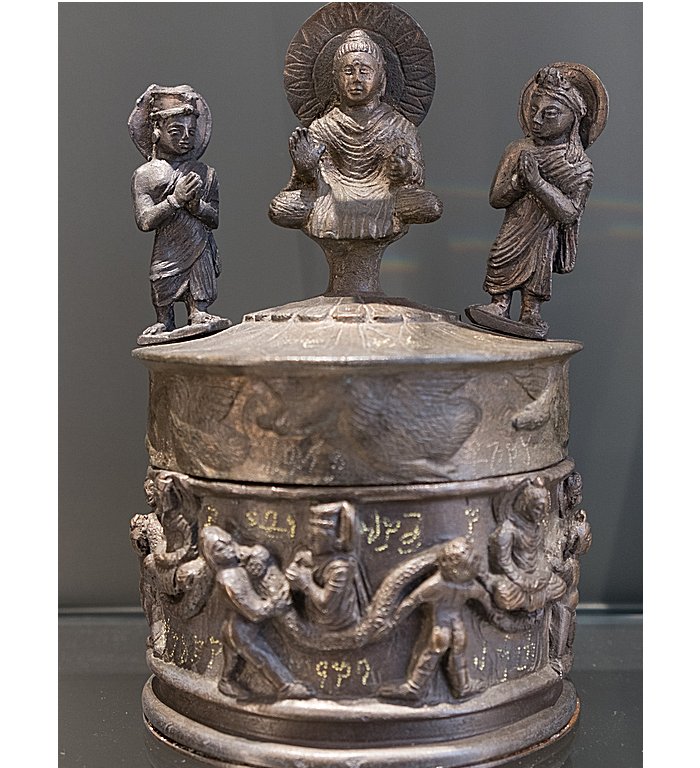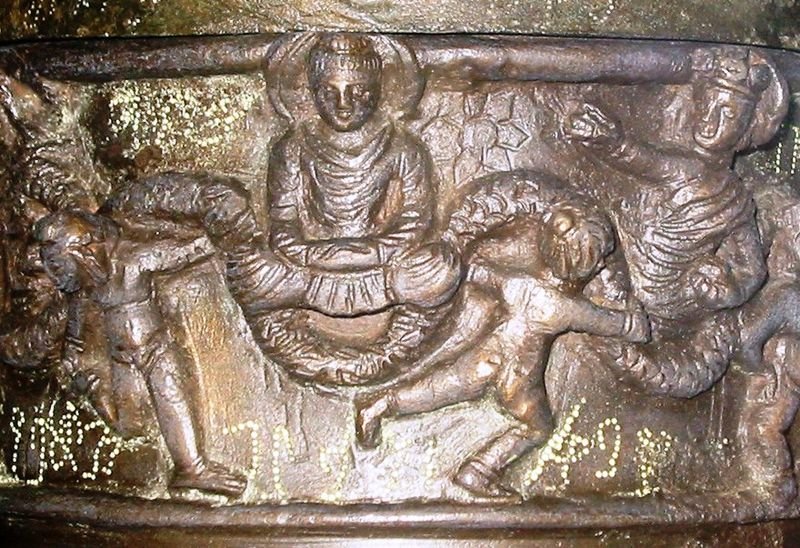Kanishka Casket – Beautiful Ancient Buddhist Treasure In Gilded Copper
A. Sutherland - AncientPages.com - The Kanishka Casket (known as the Kanishka reliquary) is a beautiful Buddhist treasure of gilded copper. The relic dates back to the first year of the reign of the Kushan emperor Kanishka, in 127 AD.
Kanishka casket, Asia, G33 South Asia British Museum, England. Image credit: Anthony Huan - CC BY-SA 2.0
It was discovered in a deposit chamber under the massive Kanishka stupa during British archaeological excavations in 1908 - 1909 in Shah-ji-Dheri on the peripheries of Peshawar, Pakistan. Chinese Buddhist pilgrims described this gigantic structure in the 7th century as the tallest stupa in India. It was indeed an enormous structure.
The stupa is believed to have influenced later constructions of stupas throughout ancient Turkistan. These wooden towers, topped with metal chatras (chhatra (meaning "umbrella"), made such buildings act as lightning rods.
It was probably considered dangerous, so this structure gradually disappeared.
Undoubtedly, the Kanishka stupa is a valuable historical and cultural landmark, but so is the Kanishka Casket, which was unearthed with three small bone fragments of Buddha. The bones were transported to Burma by the British following the excavation, where they are still stored.
In Peshawar, Pakistan, the Kanishka stupa has been described as one of the tallest in the world and has been visited by early Chinese Buddhist pilgrims. One of them was Faxian (337 AD – c. 422 AD), a Chinese Buddhist monk and translator who traveled by foot from China to India, visiting sacred Buddhist sites.
The Kanishka Casket, is the precious the artifact (just over 19 cm in height, with a diameter of 10 cm or more) is now in the Peshawar Museum, and the British Museum has its copy.
Detail of the Buddha, surrounded by cherubs, with devotee or bodhisattva. Image source
The casket is dedicated to the Kharoshthi script, an ancient Indian script used in Gandhara (now Pakistan and north-eastern Afghanistan) to write Gandhari Prakrit and Sanskrit. The script was also used in Central Asia.
The inscription reads:
"In Kanishkapura city, this incense box is the great king Kanishka's monastery's superintendents of construction of the fire hall, Mahasena's and Samgharakshita's, donation.
May it be for the benefit and pleasure of all living beings. In possession of the Sarvastivadin teachers."
Originally it was long believed that the text is signed by a Greek artist named Agesilas, who oversaw work at Kanishka's stupas ('caitya'), confirming the direct involvement of Greeks with Buddhist realizations at such a late date:
"The servant (dasa) Agisalaos, the superintendent of works at the vihara of Kanishka in the monastery of Mahasena" ("dasa agisala nava-karmi ana*kaniskasa vihara mahasenasa sangharame").
However, recent cleaning of the Kanishka Casket revealed that the inscription's old reading was inaccurate. Instead, the name is to be read 'agnisala' (instead of 'Agisalaos') and refers to the monastery, not a person.
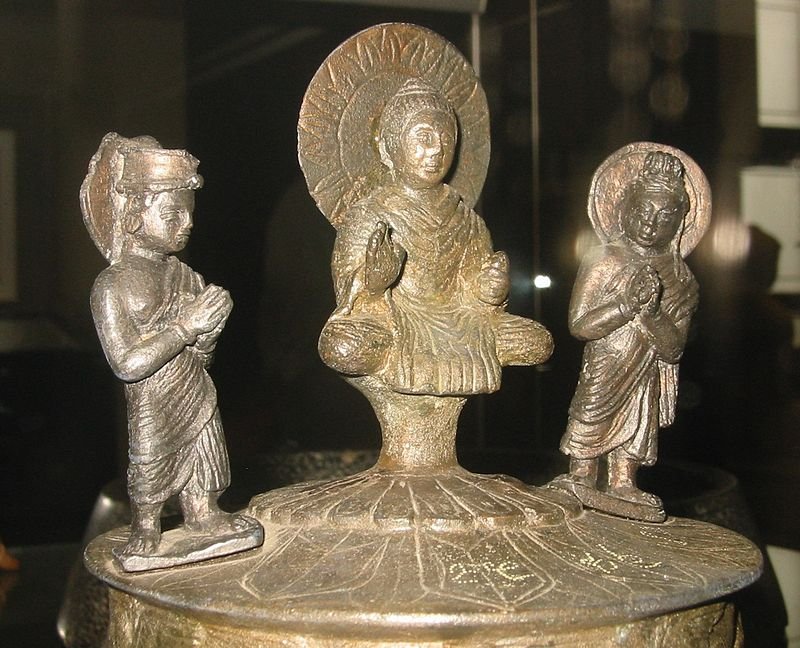 Kanishka Casket - Detail of the Indra, Buddha, Brahman trilogy. Image source
Kanishka Casket - Detail of the Indra, Buddha, Brahman trilogy. Image source
The casket's lid depicts the Buddha on a lotus pedestal and worshipped by Brahma and Indra.
"On the body of the casket, there is a standing figure of a man in Kushana costume and a row of small, active naked figures carrying a garland. In its swags appear other figures, either half-length or composed in the attitude of meditation". 1
The edge of the lid is decorated by a frieze of flying geese, or hamsa, used in Hinduism and Buddhism, as a symbol of protection against the evil eye and the symbol representing the interplay of the body's body chakras, the concept found in the early traditions of Hinduism. The 'hamsa' also means the travel of departing souls and the removal from samsara (the idea of rebirth and "life, matter, existence," all moving in cycles), a fundamental belief of most Indian religions.
The body of the casket represents a Kushan monarch, probably Kanishka in person, with the Iranian Sun god and Moon god at his side. On the sides are two images of a seated Buddha, worshiped by a royal figure, possibly a bodhisattva (one who can reach nirvana but delays doing so through compassion for suffering beings.)
Kanishka (or Kanishka the Great) was an emperor of the Kushan dynasty in the second century (c. 127–150 CE). He is famous and remembered for his military, political, and spiritual achievements. His native language is unknown.
Written by – A. Sutherland - AncientPages.com Senior Staff Writer
Updated on April 11, 2023
Copyright © AncientPages.com All rights reserved. This material may not be published, broadcast, rewritten or redistributed in whole or part without the express written permission of AncientPages.com
Expand for references- Myer, Prudence R. "Again the Kanishka Casket." The Art Bulletin48, no. 3/4 (1966): 396-403
Loeschner Hans, “The Stūpa of the Kushan Emperor Kanishka the Great”
More From Ancient Pages
-
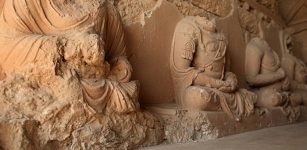 Takshashila: Renowned Learning Center That Attracted Buddhist Masters, Disciples And Students Of The World
Featured Stories | Jul 23, 2016
Takshashila: Renowned Learning Center That Attracted Buddhist Masters, Disciples And Students Of The World
Featured Stories | Jul 23, 2016 -
 Ancient Roman Sarcophagus With A Female Skeleton And A Perfume Bottle Discovered In Turkey
Archaeology | Dec 27, 2019
Ancient Roman Sarcophagus With A Female Skeleton And A Perfume Bottle Discovered In Turkey
Archaeology | Dec 27, 2019 -
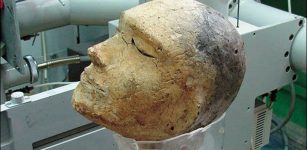 Mystery Of Unique 2,100-Year-Old Human Clay Head With A Ram’s Skull Inside
Archaeology | Apr 18, 2020
Mystery Of Unique 2,100-Year-Old Human Clay Head With A Ram’s Skull Inside
Archaeology | Apr 18, 2020 -
 Heimdallr (Heimdall): Norse God That ‘Illuminates The World’ And Guards The Rainbow Bridge Bifrost In Asgard
Norse Mythology | Feb 6, 2016
Heimdallr (Heimdall): Norse God That ‘Illuminates The World’ And Guards The Rainbow Bridge Bifrost In Asgard
Norse Mythology | Feb 6, 2016 -
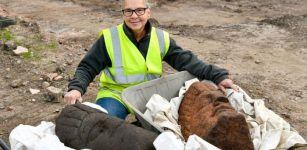 Unique And Priceless Large Roman Sculptures Found At Carlisle Cricket Club
Archaeology | May 25, 2023
Unique And Priceless Large Roman Sculptures Found At Carlisle Cricket Club
Archaeology | May 25, 2023 -
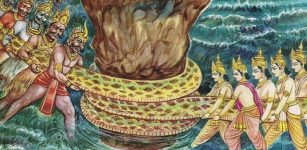 Churning Of The Ocean: Great Hindu Story Of Creation From Mahabharata And Purana
Featured Stories | Jun 16, 2018
Churning Of The Ocean: Great Hindu Story Of Creation From Mahabharata And Purana
Featured Stories | Jun 16, 2018 -
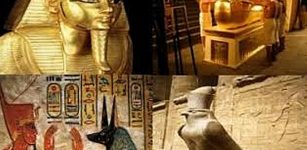 10 Fascinating Facts About Pharaohs
Ancient History Facts | Jun 21, 2016
10 Fascinating Facts About Pharaohs
Ancient History Facts | Jun 21, 2016 -
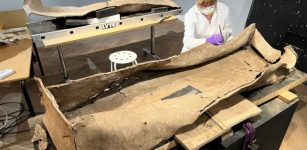 Ancient Roman Coffin Found In Leeds Revealed To The Public For The First Time
Archaeology | Apr 22, 2024
Ancient Roman Coffin Found In Leeds Revealed To The Public For The First Time
Archaeology | Apr 22, 2024 -
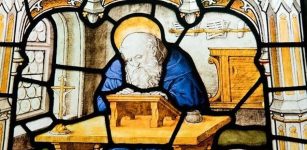 On This Day In History: Feast Day Of The Venerable Bede – Remarkable Priest, Monk And Scholar – On May 25, 735
News | May 25, 2016
On This Day In History: Feast Day Of The Venerable Bede – Remarkable Priest, Monk And Scholar – On May 25, 735
News | May 25, 2016 -
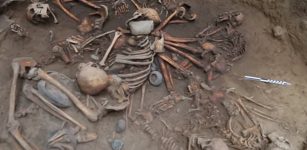 Linked Human Skeletons Lying In Spiral Circle Unearthed In Pre-Aztec Burial Pit Near Mexico City
Archaeology | Feb 7, 2018
Linked Human Skeletons Lying In Spiral Circle Unearthed In Pre-Aztec Burial Pit Near Mexico City
Archaeology | Feb 7, 2018 -
 Aqrabuamelu – Mysterious Scorpion Men In Babylonian Mythology
Featured Stories | Jan 19, 2016
Aqrabuamelu – Mysterious Scorpion Men In Babylonian Mythology
Featured Stories | Jan 19, 2016 -
 Strange Story Of Tecumseh’s Comet, Black Sun Prophecy And New Madrid Earthquakes – The Biggest Earthquakes In American History
Ancient Mysteries | Nov 14, 2018
Strange Story Of Tecumseh’s Comet, Black Sun Prophecy And New Madrid Earthquakes – The Biggest Earthquakes In American History
Ancient Mysteries | Nov 14, 2018 -
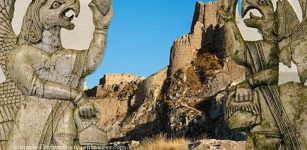 Ancient Settlement Inhabited By Urartian People – Unearthed
Archaeology | Oct 13, 2020
Ancient Settlement Inhabited By Urartian People – Unearthed
Archaeology | Oct 13, 2020 -
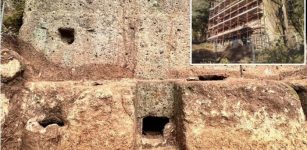 Who Is Buried In The Giant Etruscan Tomb At San Giuliano Necropolis?
Archaeology | Mar 13, 2024
Who Is Buried In The Giant Etruscan Tomb At San Giuliano Necropolis?
Archaeology | Mar 13, 2024 -
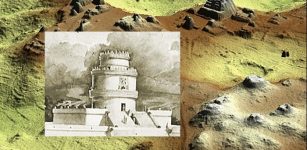 Mysterious El Caracol At Chichen Itza: What Did Maya Astronomer-Priests Observe In The Sky?
Archaeoastronomy | May 24, 2019
Mysterious El Caracol At Chichen Itza: What Did Maya Astronomer-Priests Observe In The Sky?
Archaeoastronomy | May 24, 2019 -
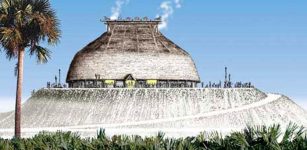 Why Were The 4,000-Year-Old Native American Shell Ring Villages Suddenly Abandoned?
Archaeology | Mar 3, 2022
Why Were The 4,000-Year-Old Native American Shell Ring Villages Suddenly Abandoned?
Archaeology | Mar 3, 2022 -
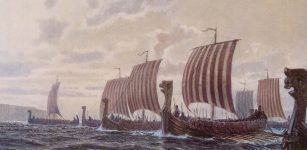 Huge Viking Winter Camp Unearthed In England
Archaeology | May 19, 2017
Huge Viking Winter Camp Unearthed In England
Archaeology | May 19, 2017 -
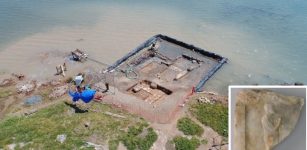 Ancient Greek Seven-Room Building And Treasures Found Underwater Off The Coast Of Salamis
Archaeology | Nov 1, 2023
Ancient Greek Seven-Room Building And Treasures Found Underwater Off The Coast Of Salamis
Archaeology | Nov 1, 2023 -
 3,000-year-old knight discovered at the Palidli necropolis
Civilizations | Aug 22, 2015
3,000-year-old knight discovered at the Palidli necropolis
Civilizations | Aug 22, 2015 -
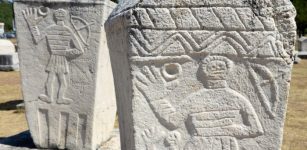 Enigmatic ‘Stone Sleepers’ – Megalithic Tombstones ‘Stecci’ In The Western Balkans
Civilizations | Dec 3, 2018
Enigmatic ‘Stone Sleepers’ – Megalithic Tombstones ‘Stecci’ In The Western Balkans
Civilizations | Dec 3, 2018

